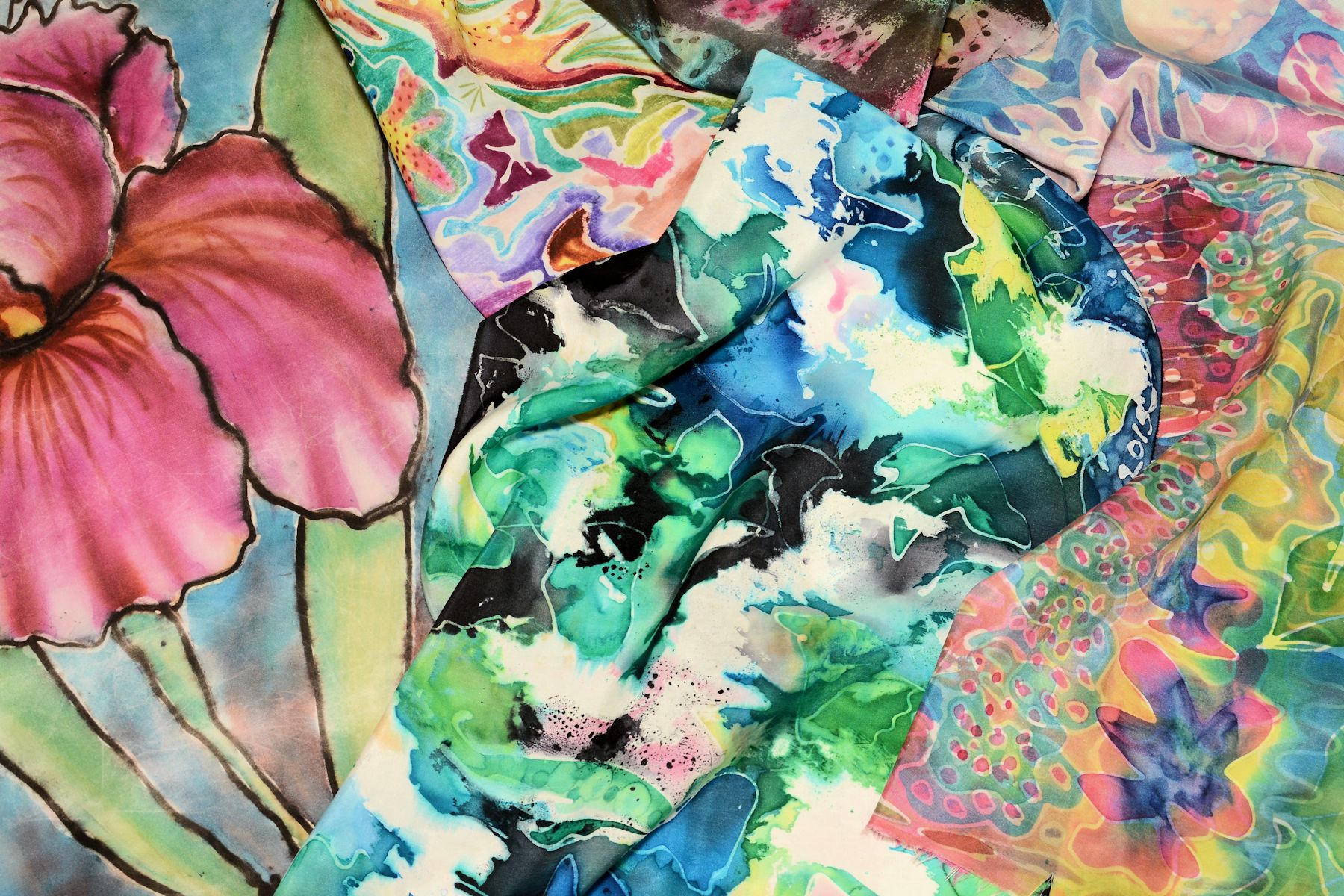How to Set Dye
Methods for how to set dye in small art pieces of acid dye painted, dye paste stamped, and soy wax batik silk
Your finished silk artwork will have more intense colors, and less dye will wash out, if you wait for at least a day before setting the dye. Japanese silk artists wait up to several months before setting and finishing their pieces. Waiting makes a big difference, and helps the silk bond chemically to the dye.
These methods use steam setting in an acidic steam bath, for about 60-90 minutes. Distilled vinegar is used for the acid because it’s readily available and doesn’t impact the color. You can also use citric acid if it’s available.
Of the dye colors, red sets the easiest, then blues (almost as well as reds,) then yellows (and its mixtures of green, brown, and orange,) with black the hardest to set. Expect some of the most concentrated dyes (black or sometimes other colors) to wash out even with an excellent steam set, because of the concentration of the dye. If the dye was set properly, only the excess will come out but leave the color.
Steam setting
Stove top Vegetable Steamer Method
This is the most reliable method if you have a steamer.
- Roll the piece in plain newsprint, enclosing the silk. Try to keep it crease-free. If you wrinkle or fold the silk while rolling it, you may end up with permanent creases.
- Make a ring or coil, and secure it with masking tape, so it fits in the strainer of the stove top steamer. Make the ring slightly smaller so it only touches the bottom, not the sides of the steamer.
- Put 2-3 cups of water with 1 T. vinegar per cup of water in the pan underneath, or enough to come to about 1/2″ of the strainer tray. Set the strainer with silk in the steamer pan and cover.
- Simmer, steaming for 1-2 hours, longer for blacks or yellow shaded dyes. It’s hard to over-steam so allow ample time.
- Check it a couple times to make sure the pan doesn’t go dry, adding more hot water if necessary. You don’t have to add more vinegar.
- Remove and unroll the silk. Test a bit, preferably of blacks or yellow mixtures, under water. If it’s not fully set, re-roll and continue steaming.
- Wash your steamer very well, preferably with an abrasive pan cleaner, to remove all dye and wax.
- The newsprint will soak up most of the wax. Proceed to Finishing, below. (Soy wax soaked newsprint makes great natural barbecue starter.)
Microwave method
This works fairly well but you must watch it because instructions are imprecise due to microwave variability. You have to use trial and error until you perfect this method with your appliance. Keep notes on what works for you.
- Put a cup of water in a pint jar with 1 T vinegar, in the middle of the microwave tray.
- Roll the piece in plain newsprint, and form the roll into a ring, securing with masking tape. Set it on the microwave tray around the pint jar of water.
- Microwave for 30 minutes or so on 70% heat. Microwaves are different so check at 10 minute intervals. If there’s any indication of the paper turning brown, reduce the heat by 20%, change out the newsprint if it’s browning, and check the water level. Or, if it’s not even boiling the water then increase the heat to 100% and increase the time to 40-60 minutes total.
- You may want to test a little corner of the piece, especially blacks and yellows, with water to see if the dye set properly. If the dye runs, then repeat.
- The newsprint will soak up most of the wax. Proceed to Finishing, below.
Boiling method
This method risks dye fading, or bleeding some of the colors together, but it’s the simplest. If much black dye has been used then there will probably be bleeding and dulling of other colors.
- Bring a small (old) pot of water to simmer on the stove, with about 1T white vinegar per cup of water.
- When the water is simmering but not boiling, immerse the silk in the pot, laying it back and forth slowly in loose fan folds, allowing it to submerse on its own, without scrunching it too much. Poke it under the water with a spoon or stick if it doesn’t submerse on its own at each fold, but don’t stir it too much or the colors will be more likely to bleed. Any soy wax will immediately begin come to the surface.
- After 2-3 minutes turn each fold over gently with the spoon, trying to slowly expose where it’s folded on itself, so the wax is released, but try not to disturb it too much.
- Let it simmer for about half an hour, uncovered.
- Then remove the piece and rinse in cold water.
- If you simmered a soy wax batik piece, then before dumping the pot of water down the sink, add enough dish detergent and stir it to make the wax floating on the surface mix in. Clean your pan with an abrasive cleaner.
- Proceed to Finishing, below.
Dyed Silk Finishing
Optional Chemical Dye Set
Here is where you can buy chemical silk and wool acid dye set.
This method ensures the dye is fully set with maximum color intensity. You may not need this if you have left your silk for several weeks before steam setting, it’s more insurance for a good result.
- Use protective gloves.
- Fill a dishpan, stainless steel roasting pan, or glass Pyrex 13” x 9” pan with 1 ½ to 2 quarts of cold water
- Add 1T. of Jacquard acid dye set in, and mix.
- Hold your silk piece buy two upper corners, and gently fan fold the piece back and forth as you lay it in the pan, so that it is completely immersed. If it doesn’t wet itself then use a spoon to poke it down into the chemical water. Let it sit in the mixture for about 10 minutes.
- Lift it out with the spoon and rinse well in cold water.
- This chemical is slightly toxic. Make sure to clean your pan, spoon, work surfaces, and hands very well with soap and water, then rinse well.
Wash, dry, press
- First rinse the piece in ample running cold water, then gradually turn up the temperature to the warm, then hot. Hold it at the upper corners and let the water run over it. You may want to rub a little the darkest areas to get any excess dye out.
- Wash out the piece in the sink or dishpan with warm water (hot water if soy wax was used) with dish soap or Woolite. Rinse well until no soap or color comes out.
- Lay out flat until mostly dry. A clean countertop works well – just check for oil or grease first.
- When damp, press under a muslin cloth with an iron set on wool/silk.
- If it dries completely before pressing, then use a spritzer to dampen the piece before pressing.
- FYI: Most silk can be hand washed and pressed in this manner.


